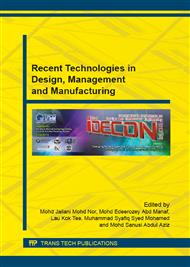p.47
p.52
p.59
p.63
p.68
p.73
p.79
p.83
p.88
The Influence of the Microwave Plasma Nitrided Ti6Al4V Substrate Properties to the Duplex Coating Performance
Abstract:
Titanium alloys, especially TI6Al4V has been used in many industries such as aerospace applications, medical application and automotive applications. This is because it has beneficial properties such as low density, high strength to weight ratio, low modulus elasticity, excellent corrosion resistance and etc. However, titanium and its alloys have limited use in mechanical engineering applications involving sliding wear or abrasion due to poor wear resistance. Therefore, the duplex coating concept was introduced with the intention of the surface modification process as a pre-treatment of the substrate prior to the deposition of hardcoating process. In this study, plasma nitriding of the Ti6Al4V was performed using a microwave plasma technique at 600°C and 700°C for 1 hour, 3 hours and 5 hours, then followed by deposition of chromium nitrate (CrN) on plasma nitrided samples for duplex coating purposes. Microstructural analysis and mirohardness measurement revealed that formation of Ti2N and TiN phase indicating the formation of the compound layer was observed for substrate nitrided at temperature as low as 600°C for 1 hour and a substantial increase on the case depth obtained on plasma nitrided Ti6Al4V was observed with an increase of process temperature and time. The duplex coating obtained in this study has superior surface hardness property and improved load carrying capacity of the coating – substrate system compared to CrN coatings deposited on as received Ti6Al4V which was observed in the penetration depth analysis.
Info:
Periodical:
Pages:
68-72
Citation:
Online since:
May 2015
Keywords:
Price:
Сopyright:
© 2015 Trans Tech Publications Ltd. All Rights Reserved
Share:
Citation:


